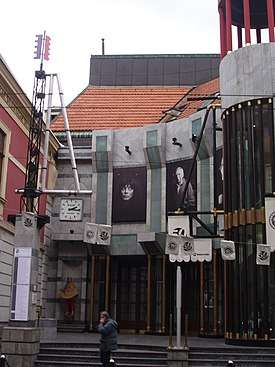Atelje 212
| Атеље 212 | |
 Atelje 212 entrance, with Zoran Radmilović's statue in front | |
 Atelje 212 Location within Belgrade | |
| Address | Svetogorska 21 |
|---|---|
| Location | Belgrade, Serbia |
| Coordinates | 44°48′51″N 20°28′05″E / 44.81417°N 20.46806°ECoordinates: 44°48′51″N 20°28′05″E / 44.81417°N 20.46806°E |
| Owner | City of Belgrade |
| Type | Theatre |
| Capacity |
386 (Main scene) 141 ("Theatre in basement" scene) |
| Construction | |
| Built | 1956 |
| Opened | 12 November 1956 |
| Renovated | 1992 |
| Website | |
|
www | |
 |
| Location within neighborhood |
Atelje 212 (Serbian Cyrillic: Атеље 212) is a theatre located in Belgrade, Serbia. It was officially founded on 12 November 1956 in the premises of the Borba building, in front of 212 chairs. The opening play was Faust, directed by Mira Trailović.
History
Although its official inauguration took place in November 1956, various plays were already staged by the same group of individuals who eventually founded Atelje 212. In mid-1956, this group performed Samuel Beckett's Waiting for Godot, a play that had been banned in all Communist countries. The performance occurred in semi-clandestine circumstances in front of some 40 audience members on a ramshackle makeshift stage in painter Mića Popović's personal atelier.[1] This came on the heels of the fiasco, regarding the ban of Godot in Beogradsko dramsko pozorište one year earlier, a staging that was being prepared by theater director Vasilije Popović with Ljuba Tadić, Rade Marković, Bata Paskaljević, Mića Tomić, and Tatjana Lukjanova among the cast. After this makeshift performance the troupe grew into a real theater that got its home in Borba building later that year. On 17 December 1956, Godot had a proper premiere at the new location, which was its first performance that was open to the public in post-World War II Eastern Europe.
Right from its start, Atelje 212 became well known for its avant-garde repertoire.
The first directors of the theatre were Radoš Novaković and Bojan Stupica, but Mira Trailović soon became director, moving up from the position of assistant director.
After a few years, the theatre moved to its current building, designed by Bojan Stupica. The building has a retractable roof, which is opened in summer.
See also
References
External links
| Wikimedia Commons has media related to Atelje 212. |